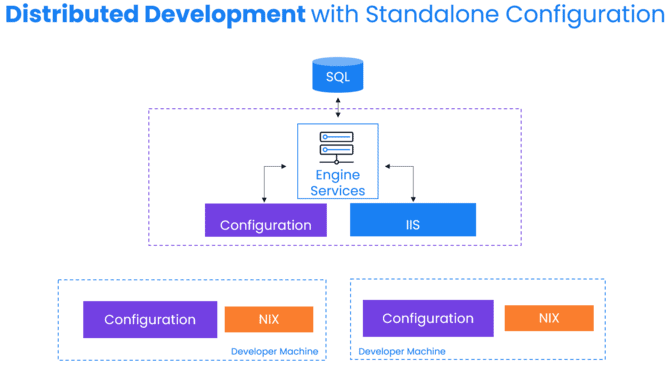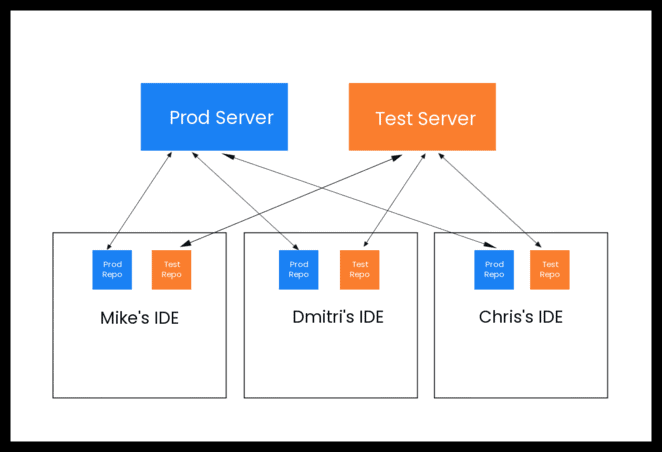In my previous blog — Corepoint 7.5.3 features Administration REST API, enhances auditing and configuration — I talked about three main initiatives that we’re pursuing for Corepoint. The goal of these initiatives is to enable our customers and partners to effectively navigate existing and upcoming challenges in healthcare interoperability. Today, I will focus on the Distributed Development initiative.
Improving productivity for hybrid and remote integration teams
Over the past several years, remote and hybrid work have seen an incredible boom. We experienced that transition ourselves, and so have our customers, who had to quickly switch their IT teams to remote work.
At the same time, merger and acquisition (M&A) activity has been accelerating across the healthcare industry, leading to rapid inorganic growth. As a result, the ability to efficiently work and collaborate remotely has become an essential part of interoperability service.
Typically, to facilitate remote work where PHI data is involved, our customers either establish VPN or another dedicated remote access solution, such as Citrix. This enables access to the work environment from the comfort of their home office while keeping data access secure.
While remote and hybrid work may create some additional complexities and layers of remote work infrastructure, we don’t believe it has to be this way!
With the upcoming Corepoint Distributed Development features, we aim to make this necessary part of interoperability much easier.
The Corepoint perspective on Distributed Development
So, what is Distributed Development? Per its common definition (Wikipedia), Distributed Development is a Research and Development model “where the project members may not see each other face to face, but they are all working collaboratively toward the outcome of the project.” Taking into consideration workflows that are common in healthcare interoperability, I would like to define Distributed Development for an integration engine as the following set of capabilities:
- Configuration management
- Concurrent collaboration
- Ability to work on interface changes offline, without live connection to server
- Collaboration from those in different geographic locations
- Ability to promote configuration changes remotely
Note that these capabilities offer value to a wide range of integration teams — from small organizations, where one person is responsible for all of the interoperability, to large providers and OEMs where integration teams consist of many dozens of developers and analysts.
Distributed Development tools available now in Corepoint
The great news is that Corepoint already includes a robust set of tools that enable remote development. Configuration Management allows for organizing and auditing of interface changes. Combined with Workspaces and Repositories features, these capabilities have delivered a robust collaboration experience in Corepoint for quite some time.
More recently, we’ve made investments in enabling offline development with the introduction of standalone Configuration in version 7.4.0. Standalone Configuration performs a function of Integrated Development Environment (IDE) and can be installed on relatively modest hardware, such as a laptop. This means that Corepoint developers have an option of installing IDE without the Corepoint Integration Engine services, IIS for the Corepoint Monitor or Microsoft SQL Server®. With IDE, you can create and modify Corepoint interfaces remotely and offline, such as when traveling, and export changes to a target server when they are ready.

In our April 2023 Corepoint User Group session, Dan Sabo and I went over the existing features and discussed our future plans. Our audience especially appreciated Dan’s expert explanation of Corepoint Configuration Management best practices. (As always, visit the Community for deep dives into this and other Corepoint topics).

What’s next for Distributed Development in Corepoint
The next phase of Corepoint Distributed Development capabilities are being influenced by experiences gained from our Corepoint as a Service as well as years of experience supporting on premise enterprise deployments of our product.
In the upcoming features, Corepoint developers will be able to pull and push changes to a remote Corepoint server directly from a local IDE. What will follow, is the ability for IDE to activate a version of a repository on a remote server.
New capabilities will work in concert with the existing ability to import and export changes to select configuration objects using Corepoint NIX format. Together, these features promise not only to simplify life of remote developers but will help promote collaboration among remote teams and make management of changes between non-production and production environments easier and safer.

Between Corepoint existing and future Distributed Development features, I’m confident that our customers will have the tools they need to improve efficiencies within their development teams while navigating hybrid and fully remote work.
If you have further questions about Corepoint existing features, please reach out to Corepoint Client Support, and if you are new to Corepoint, I invite you to engage with one of our subject matter experts. If you would like to share your thoughts about the Distributed Development initiative or would like to see how your existing or future development processes will benefit from it, please reach out to your Account Manager so we can arrange a deeper conversation.
In the next installment of this 3-part series, I will talk about our ongoing investments into Corepoint as a Service, and how it already allows our clients to rapidly enable and expand their interoperability capabilities using the power of the KLAS leading integration engine.
